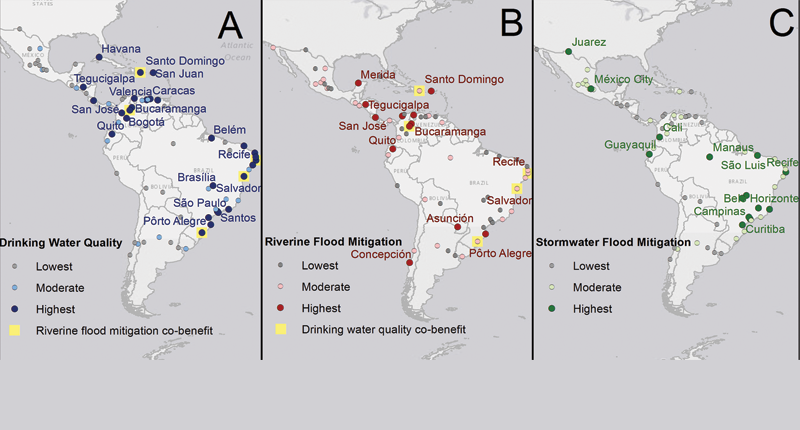Figure for Thought: When is Conservation the Right Tool to Stop the Flood?

Latin America has no shortage of water, but ensuring its growing cities have equitable access to clean water and are safe from floods is another matter, especially given the uncertainties of climate change. Experts know that urban centers should be prepared for extremes in either direction – drought or flooding – and that if conditions are right, conserving natural waterways can increase water security.
However, assessing whether conservation is appropriate for a given location requires scientific expertise and detailed analyses, which are not always available. Even so, questions remain – namely, will leveraging nature’s benefits be cost-effective compared to traditional engineering solutions, such as levees, dams, and water treatment plants?
A research team from the Science for Nature and People Partnership (SNAPP) recently published a study that provides decision makers with some first steps in considering watershed conservation to control floods or improve water quality in urban areas of Latin America. Despite its geographic focus, the principles it outlines are relevant anywhere.
Lead author Beth Tellman, a PhD student at Arizona State University, shared how their work will support decision makers:
While many cities install "green infrastructure," few can quantify how much it really reduces their overall risk portfolio and if they really save money by doing so. "Green is good" is not a helpful mantra for decision makers with tight budgets in our rapidly changing world. In fact, there are probably some places that green infrastructure will not make a measurable impact for a given risk.
Each city is unique, and natural infrastructure won't work the same everywhere. For some cities, the shape of their watershed, soil, or pattern of urban development means that they need to rely on more traditional engineering to reduce risk; yet for others, watershed conservation could be a good option.
Organizations investing in Latin America should focus on natural infrastructure solutions for cities with the dark and large blue, green, and red circles. The cities with the yellow squares are really good investment options because the SAME watershed conservation activity could both increase water quality AND reduce flood risk. Talk about a bang for your buck!
We hope this paper and our data dashboard help make the business case for nature and guide investment to the places and people that will benefit most (and not spend it in places where nature can't really make a dent in reducing risk!). Nature can't stop the flood everywhere, but it can sure make a difference in some places, which we hope to champion and highlight with our work.
###
Figure for Thought features thought-provoking figures from NCEAS-supported publications with a brief explanation from the lead author.
Cheyenne Coxon is a 2018-2019 Science Communication Fellow and graduate student at UC Santa Barbara's Bren School of Environmental Science and Management.
